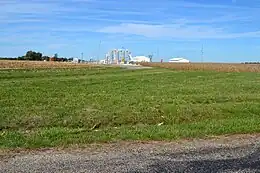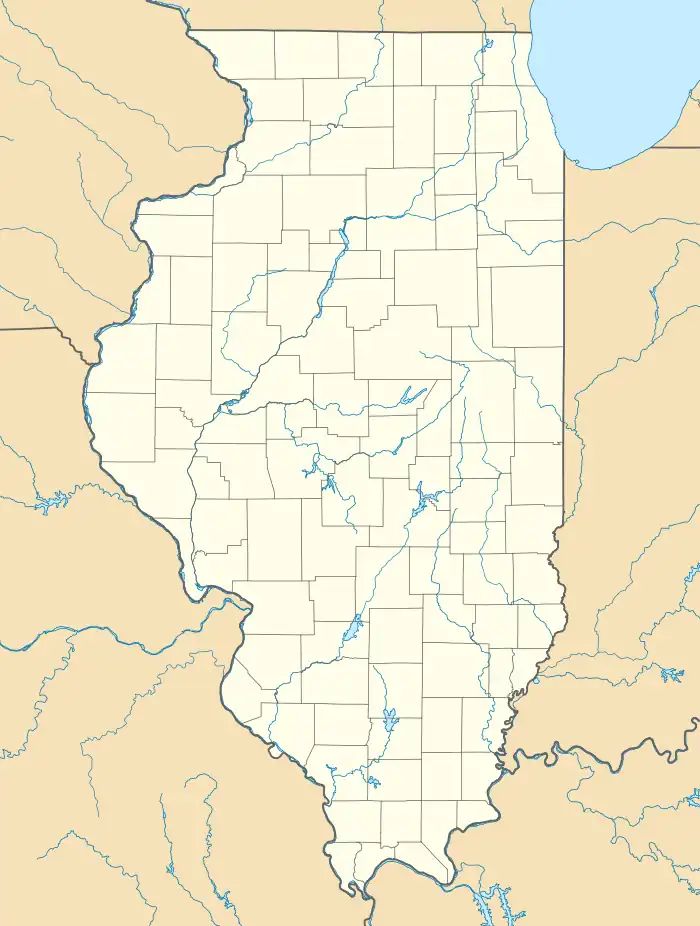Glasford crater
The Glasford crater, also known as the Glasford Disturbance, Glasford Structure,[1] and Glasford Cryptoexplosion Structure[2], is a buried impact crater in southern Peoria County, Illinois, in the United States.[3] It is one of two known meteor craters in Illinois.[4]
| Glasford crater | |
|---|---|
 Site of crater from south, at intersection of Cowser and Kingston Mines Rds. | |
| Impact crater/structure | |
| Confidence | Confirmed |
| Diameter | 4 kilometres (2.5 mi) |
| Depth | 350 metres (1,150 ft) |
| Age | < 430 Ma |
| Exposed | No |
| Drilled | Yes |
| Location | |
| Coordinates | 40°36′N 89°47′W |
| Country | USA |
| State | Illinois |
| Municipality | Glasford, Illinois |
It is 4 kilometers (2.5 mi) in diameter and the age is estimated to be less than 430 million years (Silurian or younger).[5][6] It was formed in a marine environment in the Late Ordovician period.[7][8] The meteorite is estimated between 50 to 90 million tons and likely originated in the asteroid belt between Mars and Jupiter.[9]
The Glasford crater was discovered by the Central Illinois Light Company (formerly CILCO, now Ameren) while drilling wells for underground natural gas storage.[10][11] It is not visible from the surface, as it is covered by agricultural farmland.[12][11] The present day location is near the intersection of Cowser and Kingston Mines roads.[9] It was identified in 1963 as a probable impact structure.[5][13] In the 1980s, scientists identified shatter cones.[5] Geologists estimate the meteor released a large amount of energy, roughly equivalent to 20,000 nuclear bombs, 460 million tons of TNT, or two to three times the energy of the Mount St. Helens eruption.[11][9]
According to research by geologist Charles Monson, the Glasford crater may be connected to the Great Ordovician Meteor Shower.[14] Dr. Birger Schmitz's study suggests that the dust from the meteor impact may have impacted Earth's climate and contributed to the mid-Ordovician Ice Age.[4][14]
References
- Freeberg, Jacquelyn H. (1966). Terrestrial impact structures: a bibliography. Washington: U.S. Govt. Print. Off. p. 42.
{{cite book}}: CS1 maint: date and year (link) - Ryan, Robert; Buschbach, T. C. (1963). "Tectonic History of the Glasford Cryptoexplosion Structure: ABSTRACT". AAPG Bulletin. 47 (2): 368–369. ISSN 0149-1423.
- "Glasford". Earth Impact Database. Planetary and Space Science Centre University of New Brunswick Fredericton. Retrieved 2009-08-13.
- Jolley, Tiffany (2019-11-12). "Prairie Research Institute News". blogs.illinois.edu. Retrieved 2023-10-02.
- Monson, Charles C.; Sweet, Dustin; Segvic, Branimir; Zanoni, Giovanni; Balling, Kyle; Wittmer, Jacalyn M.; Ganis, G. Robert; Cheng, Guo (2019). "The Late Ordovician (Sandbian) Glasford structure: A marine‐target impact crater with a possible connection to the Ordovician meteorite event". Meteoritics & Planetary Science. 54 (12): 2927–2950. doi:10.1111/maps.13401. ISSN 1086-9379 – via Wiley.
- "Glasford". www.passc.net. Retrieved 2023-10-02.
- Alwmark, C; Monson, C.C. (2021). "CONFIRMATION OF SHOCKED QUARTZ GRAINS IN THE CRATER IN-FILL OF THE GLASFORD IMPACT STRUCTURE". 52nd Lunar and Planetary Science Conference 2021.
- Buschbach, Robert Ryan T. C. (1963). "Ordovician Explosion Structure at Glasford, Illinois". AAPG Bulletin. 47 – via ResearchGate.
- "Meteor cratered central Illinois". Burlington Hawk Eye. 1999-09-20. p. 4.
- Meteorite Research - Progress Report Archived 2006-05-24 at the Wayback Machine, Research Subcommittee, Associate Committee on Meteorites, National Research Council of Canada, 1967
- Vlahos, Nick (2017-02-20). "Nick in the AM: When a meteor landed near Glasford". Peoria Journal Star. Retrieved 2023-10-02.
- "GLASFORD IMPACT STRUCTURE – Crater Explorer". Retrieved 2023-10-02.
- "Where Meteor Crashed Near Glasford". Peoria Journal Star. 1963-04-09.
- Shelley, Tim (2019-11-19). "Glasford Meteor May Have Played A Role in Ancient Ice Age". WCBU Peoria. Retrieved 2023-10-02.


